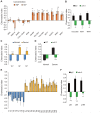A highly accurate inclusive cancer screening test using Caenorhabditis elegans scent detection
- PMID: 25760772
- PMCID: PMC4356513
- DOI: 10.1371/journal.pone.0118699
A highly accurate inclusive cancer screening test using Caenorhabditis elegans scent detection
Abstract
Early detection and treatment are of vital importance to the successful eradication of various cancers, and development of economical and non-invasive novel cancer screening systems is critical. Previous reports using canine scent detection demonstrated the existence of cancer-specific odours. However, it is difficult to introduce canine scent recognition into clinical practice because of the need to maintain accuracy. In this study, we developed a Nematode Scent Detection Test (NSDT) using Caenorhabditis elegans to provide a novel highly accurate cancer detection system that is economical, painless, rapid and convenient. We demonstrated wild-type C. elegans displayed attractive chemotaxis towards human cancer cell secretions, cancer tissues and urine from cancer patients but avoided control urine; in parallel, the response of the olfactory neurons of C. elegans to the urine from cancer patients was significantly stronger than to control urine. In contrast, G protein α mutants and olfactory neurons-ablated animals were not attracted to cancer patient urine, suggesting that C. elegans senses odours in urine. We tested 242 samples to measure the performance of the NSDT, and found the sensitivity was 95.8%; this is markedly higher than that of other existing tumour markers. Furthermore, the specificity was 95.0%. Importantly, this test was able to diagnose various cancer types tested at the early stage (stage 0 or 1). To conclude, C. elegans scent-based analyses might provide a new strategy to detect and study disease-associated scents.
Conflict of interest statement
Figures



Similar articles
-
[Development of an Early Cancer Detection Method Using the Olfaction of the Nematode Caenorhabditis elegans].Yakugaku Zasshi. 2019;139(5):759-765. doi: 10.1248/yakushi.18-00185-4. Yakugaku Zasshi. 2019. PMID: 31061346 Review. Japanese.
-
Accuracy evaluation of the C. elegans cancer test (N-NOSE) using a new combined method.Cancer Treat Res Commun. 2021;27:100370. doi: 10.1016/j.ctarc.2021.100370. Epub 2021 Apr 9. Cancer Treat Res Commun. 2021. PMID: 33901923
-
[Early Diagnosis of Cancer Using Nematoda C. elegans].Gan To Kagaku Ryoho. 2018 Jun;45(6):916-920. Gan To Kagaku Ryoho. 2018. PMID: 30026413 Japanese.
-
A Caenorhabditis elegans behavioral assay distinguishes early stage prostate cancer patient urine from controls.Biol Open. 2021 Mar 26;10(3):bio057398. doi: 10.1242/bio.057398. Biol Open. 2021. PMID: 33685856 Free PMC article.
-
A novel approach to cancer screening using the nematode Caenorhabditis elegans-based detection assays.Klin Onkol. 2024;38(3):184-188. doi: 10.48095/ccko2024184. Klin Onkol. 2024. PMID: 38960674 Review. English.
Cited by
-
Organs-on-Chips Platforms Are Everywhere: A Zoom on Biomedical Investigation.Bioengineering (Basel). 2022 Nov 3;9(11):646. doi: 10.3390/bioengineering9110646. Bioengineering (Basel). 2022. PMID: 36354557 Free PMC article. Review.
-
Canine scent detection of canine cancer: a feasibility study.Vet Med (Auckl). 2017 Oct 26;8:69-76. doi: 10.2147/VMRR.S148594. eCollection 2017. Vet Med (Auckl). 2017. PMID: 30050858 Free PMC article.
-
C. elegans as a Powerful Tool for Cancer Screening.Biomedicines. 2022 Sep 23;10(10):2371. doi: 10.3390/biomedicines10102371. Biomedicines. 2022. PMID: 36289633 Free PMC article. Review.
-
Application of C. elegans cancer screening test for the detection of pancreatic tumor in genetically engineered mice.Oncotarget. 2019 Sep 10;10(52):5412-5418. doi: 10.18632/oncotarget.27124. eCollection 2019 Sep 10. Oncotarget. 2019. PMID: 31534627 Free PMC article.
-
Olfactory dysfunction in aging and neurodegenerative diseases.Ageing Res Rev. 2021 Sep;70:101416. doi: 10.1016/j.arr.2021.101416. Epub 2021 Jul 27. Ageing Res Rev. 2021. PMID: 34325072 Free PMC article. Review.
References
-
- Boyle P (2008) World Cancer Report 2008. Lyon, France: IARC Press;
-
- McCulloch M, Jezierski T, Broffman M, Hubbard A, Turner K, Janecki T (2006) Diagnostic accuracy of canine scent detection in early- and late-stage lung and breast cancers. Integr Cancer Ther 5: 30–39. - PubMed
Publication types
MeSH terms
Substances
Grants and funding
LinkOut - more resources
Full Text Sources
Other Literature Sources

